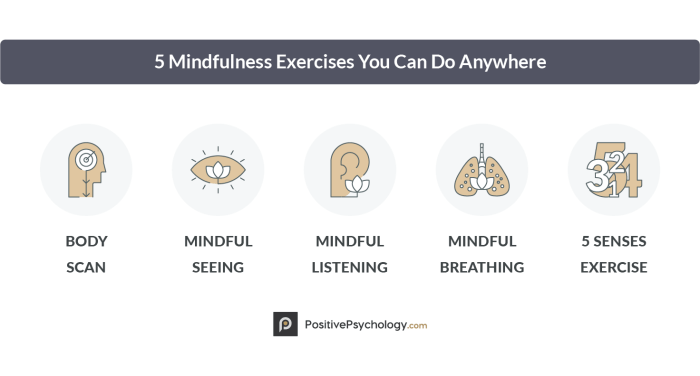Mindfulness Exercises, a path to tranquility and focus, are essential in today’s fast-paced world where distractions abound. Dive into this guide to explore the transformative power of mindfulness practices.
From defining mindfulness exercises to exploring different techniques, this comprehensive overview will equip you with the tools to incorporate mindfulness into your daily routine effortlessly.
Introduction to Mindfulness Exercises

Mindfulness exercises are activities or techniques that help individuals focus their attention on the present moment. These exercises aim to increase awareness of thoughts, feelings, sensations, and the environment without judgment.
Practicing mindfulness exercises has numerous benefits, including stress reduction, improved emotional regulation, enhanced focus and concentration, and increased overall well-being. Regular practice of mindfulness exercises can also help individuals manage anxiety, depression, and other mental health conditions.
Popular Mindfulness Exercises
- Body Scan: This exercise involves focusing on different parts of the body, starting from the toes and moving up to the head, while paying attention to any sensations or feelings present.
- Deep Breathing: Deep breathing exercises help individuals connect with their breath and promote relaxation. It involves taking slow, deep breaths in and out, focusing on the sensation of the breath entering and leaving the body.
- Mindful Walking: Mindful walking involves paying attention to each step taken, the sensation of the feet touching the ground, and the movement of the body as you walk. It can be done indoors or outdoors.
- Loving-Kindness Meditation: This practice involves cultivating feelings of love, compassion, and kindness towards oneself and others. It helps promote positive emotions and a sense of connection with others.
Types of Mindfulness Exercises

When it comes to mindfulness exercises, there are various techniques that individuals can practice to cultivate awareness and presence in their daily lives.
Meditation
- Meditation is a common mindfulness practice that involves focusing the mind and eliminating distractions.
- Beginners may start with simple breath awareness meditation, while advanced practitioners may explore different types like loving-kindness or body scan meditation.
- Regular meditation can help reduce stress, improve concentration, and enhance overall well-being.
Deep Breathing
- Deep breathing exercises are another form of mindfulness practice that involves focusing on the breath and inhaling deeply through the nose and exhaling slowly through the mouth.
- Beginners can start with basic deep breathing techniques, while advanced practitioners may incorporate breathwork into yoga or tai chi practices.
- Deep breathing exercises can help calm the mind, reduce anxiety, and promote relaxation.
Body Scan
- Body scan is a mindfulness exercise that involves systematically scanning the body for sensations and bringing awareness to different parts of the body.
- Beginners may start with a guided body scan meditation, while advanced practitioners may practice body scanning in silence and with greater depth of focus.
- Body scan exercises can help individuals develop body awareness, release tension, and improve mind-body connection.
Integration into Daily Routines
- Regardless of the type of mindfulness exercise, it can be integrated into daily routines by setting aside dedicated time each day for practice.
- Beginners may start with short sessions and gradually increase the duration, while advanced practitioners may incorporate mindfulness into daily activities like eating, walking, or working.
- By incorporating mindfulness exercises into daily routines, individuals can develop a sense of presence, reduce stress, and enhance overall mental well-being.
Techniques for Practicing Mindfulness
Practicing mindfulness involves various techniques that help in cultivating awareness and presence in the moment. One of the most common techniques is mindfulness meditation, which can be done in a few simple steps.
Mindfulness Meditation
- Find a quiet and comfortable place to sit or lie down.
- Close your eyes and focus on your breath, either the sensation of air entering and leaving your nostrils or the rising and falling of your abdomen.
- Notice when your mind starts to wander and gently bring your focus back to your breath without judgment.
- Continue this practice for a few minutes to start and gradually increase the duration as you become more comfortable.
Breathing Techniques
Breathing techniques are essential in mindfulness exercises as they help in grounding and centering yourself in the present moment. One common breathing technique used is diaphragmatic breathing, also known as belly breathing.
- Find a comfortable position, either sitting or lying down, and place one hand on your chest and the other on your abdomen.
- Inhale deeply through your nose, allowing your abdomen to rise while keeping your chest still.
- Exhale slowly through your mouth, feeling your abdomen fall as you release the breath.
- Repeat this process for a few minutes, focusing on the sensation of your breath moving in and out of your body.
Enhancing Focus and Presence
To enhance focus and presence during mindfulness practices, it’s important to eliminate distractions and create a conducive environment for your practice.
- Choose a quiet and comfortable space where you won’t be disturbed.
- Set aside dedicated time for your mindfulness practice each day, whether it’s in the morning or before bed.
- Avoid multitasking and focus on one task at a time to improve your ability to be present in the moment.
- Practice self-compassion and patience with yourself, as mindfulness is a skill that develops over time with consistent practice.
Mindfulness Exercises for Specific Situations
Mindfulness exercises can be tailored to specific situations to address different needs and challenges individuals may face in their daily lives. Here, we will explore mindfulness exercises for stress relief and anxiety management, improving sleep quality, as well as enhancing productivity and concentration.
Stress Relief and Anxiety Management
- Practice deep breathing exercises to help calm the mind and body during stressful situations.
- Engage in body scan meditations to increase awareness of tension and release it gradually.
- Use grounding techniques such as focusing on the present moment through senses like touch or sight.
- Try mindfulness walking by paying attention to each step and the sensations in your body.
Improving Sleep Quality
- Wind down before bed with a guided meditation or body relaxation exercise to signal to your body that it’s time to sleep.
- Practice gratitude journaling to shift your focus from worries to positive thoughts before going to sleep.
- Use progressive muscle relaxation techniques to release physical tension and prepare for a restful night’s sleep.
Enhancing Productivity and Concentration
- Start the day with a mindfulness meditation to set a focused intention for your tasks ahead.
- Take short mindfulness breaks throughout the day to re-center your attention and prevent burnout.
- Use mindful listening techniques during meetings or conversations to improve communication and understanding.
Incorporating Mindfulness Exercises into Daily Life
When it comes to incorporating mindfulness exercises into your daily routine, consistency is key. By setting aside time each day for mindfulness practice, you can reap the benefits of reduced stress, increased focus, and improved overall well-being.
Designing a Daily Mindfulness Routine
Creating a daily mindfulness routine can help you stay on track with your practice. Here are some examples of exercises you can incorporate into your daily life:
- Start your day with a short breathing exercise to center yourself before diving into your daily tasks.
- Take short mindfulness breaks throughout the day to check in with yourself and refocus your attention.
- Practice gratitude by reflecting on three things you are thankful for each evening before bed.
Practicing Mindfulness at Work or in Social Settings, Mindfulness Exercises
Mindfulness exercises can be practiced anywhere, including at work or in social settings. Here are some examples of how you can incorporate mindfulness into these environments:
- Practice deep breathing or body scan exercises during your lunch break to reset and recharge.
- Practice active listening during meetings or conversations to stay present and engaged.
- Take a mindful walk during your break to clear your mind and reduce stress.
The Importance of Consistency
Consistency in mindfulness practice is crucial for experiencing its full benefits. By making mindfulness a daily habit, you can cultivate a greater sense of awareness, presence, and inner peace. Remember, it’s not about perfection, but rather about showing up for yourself each day.
